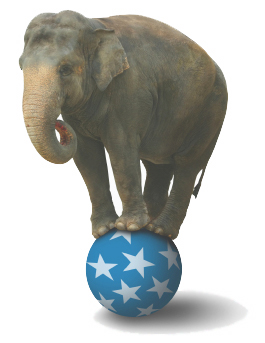
Have you been asked if you want to order a jumbo-sized meal
at a fast food restaurant lately? Maybe you have gone to a stadium and watched
replays on their jumbotron. You might have eaten jumbo shrimp or flown on a jumbo
jet. We recognize the word "jumbo” to mean that something is very large. The
way the word entered the English language has more to do with marketing, and
specifically with branding, than you might know.
On May 24, 1883, the Brooklyn Bridge, linking Manhattan
Island with Brooklyn, NY, opened for traffic. It took fourteen years to build
the bridge; the largest suspension bridge in the world at that time. The entire
structure was held in place by two massive cables that were held up by two
towers. The problem was that suspension bridges had a bad reputation in the
late 19th century. They were known to be highly unstable in strong
winds and were known to collapse under heavy loads. There was a concern that
the newly constructed bridge would give way and fall into the East River under
such conditions, and people were wary of using it. That is when P.T. Barnum,
the circus promoter, came up with a grand idea. He said he would march a parade
of elephants across the bridge to prove the integrity of its construction, and
that he would ride on the back of the largest elephant: his prized African
elephant named "Jumbo.” If the bridge could hold up under the weight of his 21
circus elephants, it certainly would hold up the New Yorkers making the
crossing.
Of course Barnum was really up to something else with his
announcement. He had purchased Jumbo from the London zoo for $10,000. The large
African elephant was the centerpiece of his traveling circus. Jumbo had been
named not for his size, but for the Swahili word for hello, "jambo,” since he
was born in Africa. Barnum instead used the word to reflect the sheer size of
the animal, which stood over 13 feet at the shoulder. When the circus came to
town, Jumbo was paraded through the streets in a massive crate pulled by a team
of horses. The sign on the side of the crate announced "Monster Elephant
JUMBO.” All that could be seen of the animal was his trunk, which he waved and
snorted out of the top of the crate. People were awed by the magnitude of what
was inside that crate. Barnum used people’s curiosity to sell tickets to his
circus and he created a marketing stir by making a word mean something was very
large: Jumbo. When the world’s largest suspension bridge was ready to open,
Barnum used the publicity the big bridge was getting to shine the spotlight on
his own brand: Jumbo elephant, jumbo bridge.
In your marketing efforts, you may have branded your
products, services or your processes used to conduct business. Here are a
couple of ideas to remember when you are doing this. First, do not get too
complicated with the naming of the brand. It should be very simple to pronounce
and to remember. If you are creating a name with over three syllables, you
might be getting too complicated. Think of the successful brands that are
around you. More than likely, you will find that they follow this syllable
count rule. For instance, you will recognize these brands that use the three
syllable or less rule: Amazon, Xerox, Apple, Hershey’s, Google, Tupperware and
Target. In fact, we tend to shorten the names of brands that are longer than
three syllables. For instance, we refer to General Motors as GM, Coca-Cola as
Coke, Minnesota Mining and Manufacturing as 3M. You also need to limit the
number of words used conveying your brand to two words. Names such as Minute
Maid, Wells Fargo and Taco Bell all fit this scheme. They are memorable. Again,
if you get too many words, the public will tend to shorten the name. Kentucky
Fried Chicken was commonly called KFC, Sears and Roebuck was shortened to be
merely Sears. These companies have changed their original brand to embrace the
shortened name, arrived at by public usage and acceptance.
Many brands are simply words that are made up. Jumbo was not
listed in the dictionary before Barnum made it mean anything that was large in
the English lexicon. The world of marketing is full of words that have become
brands that are totally made up. Many combine two concepts into a portmanteau –
or morphed word – out of two or more words, such as Pennzoil (South Penn Oil
and Zapata Petroleum), Walmart (Walton’s mart), or Verizon (Veritas – the Latin
word for "truth” and horizon). Some are shortened to their initials, such as
AT&T (American Telephone and Telegraph), UPS (United Parcel Service), and IBM
(International Business Machines).
The key to making your brand become a household name is in
the purity of its meaning. The real success of branding a word comes when it is
commonly exchanged for other words that describe its product or service. If I
say to you "will you FedEx that to me?” what I mean is: will you courier that
package overnight? If I say "could you hand me a Kleenex?” what I mean is: will
you get a facial tissue for me? Much like if I ask you to get a box of jumbo
paper clips, we understand that branded words can become part of the language
of our market and those words can have great value.
_________________________
The elephants that tested the Brooklyn Bridge, December 22, 2011, Ephemeral New York,
http://ephemeralnewyork.wordpress.com/tag/p-t-barnum-elephants
Jumbo, The Great Elephant Displayed by Barnum, About.com
May 24, 1883: Brooklyn Bridge opens, History.com
Photo by Kok Jynn Tan